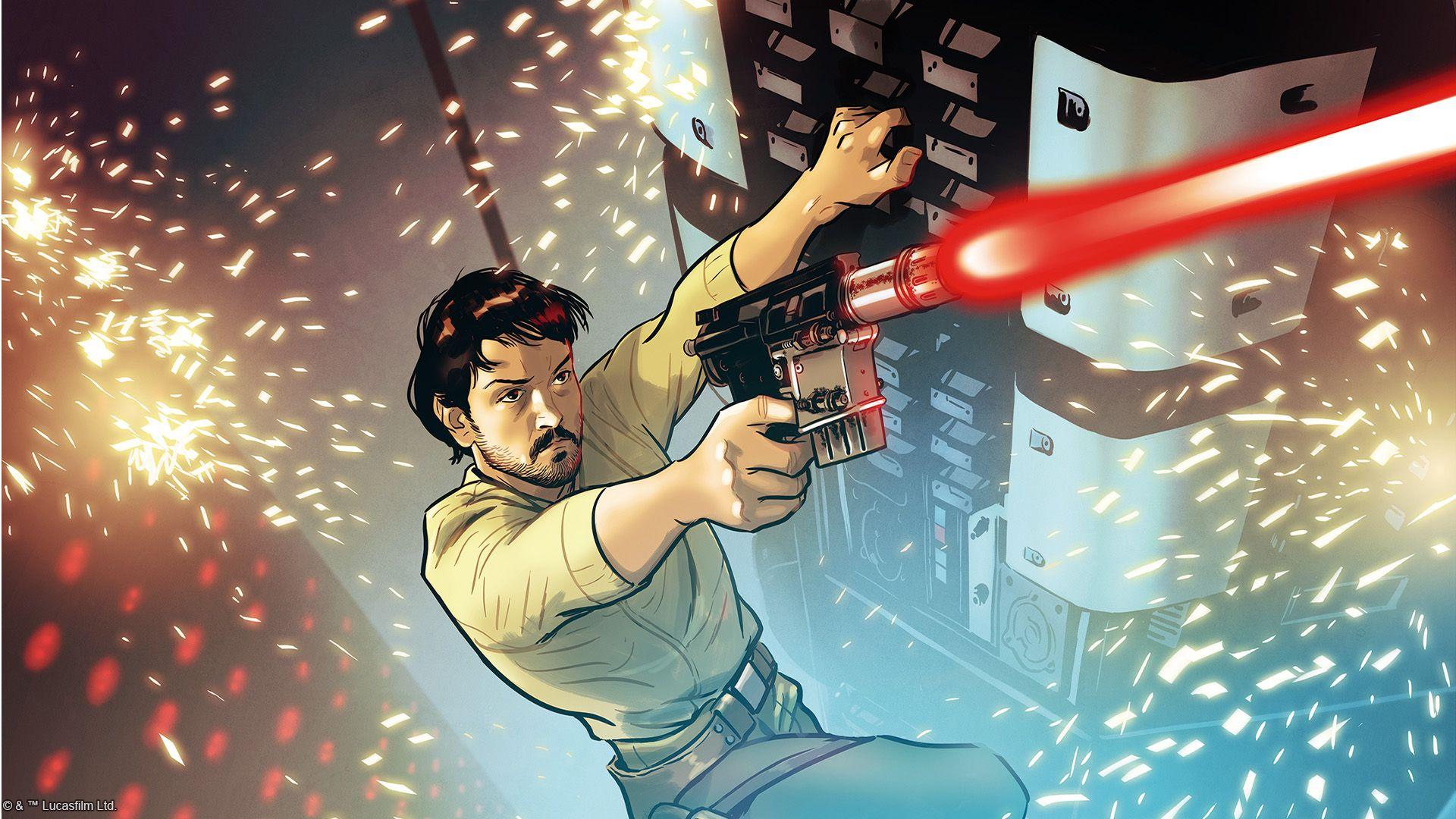Clash of Ideals
At this year’s Gen Con event, we gave a first look at Twilight of the Republic, the third set for Star Wars™: Unlimited. In that first look, we shared a brief glimpse at the pre-built starter decks of the Twilight of the Republic Two-Player Starter, which feature Ahsoka Tano and General Grievous as leaders.
Today, we want to take a deep dive into the contents of both those decks, including how they play and what cards you can find within. So, without further ado, let’s kick things off with a look at Ahsoka Tano!

As we mentioned in the first look, Ahsoka Tano (Twilight of the Republic, 11) showcases one of the set’s new keywords, Coordinate. These abilities come online once you control three or more units, so naturally Ahsoka’s gameplay revolves around having plenty of allies on the board at once. Her undeployed side can grant a friendly unit an attack boost, while her deployed side increases her own power, and both abilities are only active while she has at least three friendly units in play (remember, Ahsoka herself counts as one of these units while she’s deployed).
To help her get her Coordinate abilities active as soon as possible, Ahsoka’s deck comes with plenty of low-cost units that she can play early and often. Cards like the Soldier of the 501st (Twilight of the Republic, 141), Dendup’s Loyalist (Twilight of the Republic, 159), Phase I Clone Trooper (Twilight of the Republic, 241), and the Republic ARC-170 (Twilight of the Republic, 111) are all cheap and simple units that she can rely on in the early game to build up her forces. Some of the low-cost units in her deck even have their own Coordinate abilities, such as 332nd Stalwart (Twilight of the Republic, 240), Echo (Twilight of the Republic, 90), Coruscant Guard (Twilight of the Republic, 106), Clone Heavy Gunner (Twilight of the Republic, 158), and Republic Commando (Twilight of the Republic, 243). As soon as you have your third unit in play, all of your units’ Coordinate abilities come online at once, allowing your troops to play off each other and press the attack alongside Ahsoka herself.
Naturally, with such a heavy emphasis on Coordinate in her deck, Ahsoka’s opponents will no doubt want to focus on removing her units to keep those abilities in check. Fortunately, her deck also comes with the means of rebuilding her army quickly and efficiently. Cards like Batch Brothers (Twilight of the Republic, 144) and Drop In (Twilight of the Republic, 251) can give you two units out of just a single card play, Captain Rex (Twilight of the Republic, 97) can give you three, and Shaak Ti (Twilight of the Republic, 94) can give you an extra unit each round. In the late game, the Tranquility (Twilight of the Republic, 246) can get you one of your units back and provide a discount on the Republic units you play, ensuring that you always have enough allies to keep your Coordinate abilities going.
The rest of Ahsoka’s deck is built around the idea of having lots of units in play to work with. The 501st Liberator (Twilight of the Republic, 109) can heal your base while you control another Republic unit, the Republic Tactical Officer (Twilight of the Republic, 91) lets you attack with that Republic unit while boosting its power, and Admiral Yularen (Twilight of the Republic, 92) grants all of your Heroism units +1 HP to keep them around longer. While you have at least three units in play, call upon Clone Commander Cody (Twilight of the Republic, 114) to give everyone a buff and Overwhelm, then use Encouraging Leadership (Twilight of the Republic, 126) to make your units even stronger.
Even if you don’t have any of your high-cost units in play, Ahsoka’s deck still gives you plenty of tools to help in the mid- to late-game. Utilize a Synchronized Strike (Twilight of the Republic, 99) to take down a troublesome enemy unit, or toss out a Grenade Strike (Twilight of the Republic, 171) for some splash damage against the opposing forces (which is particularly effective against Battle Droid tokens). Equip Ahsoka’s Padawan Lightsaber (Twilight of the Republic, 248) to give her a solid power boost and then immediately attack, or call on Hevy (Twilight of the Republic, 164) to deal devastating damage to the enemy lines. Ahsoka’s mentor, Anakin Skywalker (Twilight of the Republic, 147), can provide some additional card draw to get you the tools you need, and once your base’s HP gets low, you can either utilize Anakin’s Interceptor (Twilight of the Republic, 142) for some reliable damage in space, or fly in an Eta-2 Light Interceptor (Twilight of the Republic, 244) to patch your base back up. No matter what path you take, Ahsoka’s deck allows you to be flexible and adapt to the changing situation, and once you’ve got your Coordinate abilities online, you’ll be ready to dish out some serious damage!

On the other side of the Two-Player Starter, we have General Grievous (Twilight of the Republic, 15). This notorious general of the Separatists has legions of droids under his command, and his playstyle reflects this. His undeployed side lets him grant a Droid unit Sentinel for the phase, and his deployed side can do the same alongside an attack boost. Naturally, this means his deck has lots of Droid units for him to exploit in as many ways as possible.
Plenty of those Droid units are low-cost, such as the Droid Starfighter (Twilight of the Republic, 228), Separatist Commando (Twilight of the Republic, 180), and the Super Battle Droid (Twilight of the Republic, 230). Alternatively, Grievous’s deck can also create a multitude of Battle Droid (Twilight of the Republic, T01) tokens through cards like Droid Deployment (Twilight of the Republic, 237), Poggle the Lesser (Twilight of the Republic, 80), General’s Guardian (Twilight of the Republic, 83), and Subjugating Starfighter (Twilight of the Republic, 112). Whichever method you employ, getting Droid units out early allows Grievous to grant them Sentinel and protect his base while his other low-cost units go on the offensive.
Speaking of his other units, Grievous’s personal ship, the Soulless One (Twilight of the Republic, 179), can hit impressively hard for a 1-cost unit, while the Independent Senator (Twilight of the Republic, 206) can shut down opposing threats. If a unit that Grievous granted Sentinel falls, the B1 Security Team (Twilight of the Republic, 207) can take its place. A single play of On the Doorstep (Twilight of the Republic, 190) creates three ready-to-fight Battle Droid tokens in an instant, then the MagnaGuard Wing Leader (Twilight of the Republic, 82) can let Grievous attack with two of them at once. Combine that with Kraken (Twilight of the Republic, 84) boosting the power of all friendly token units, and suddenly your opponent has to fend off a nasty assault.
For a general as ruthless as Grievous, it should come as no surprise that his deck is also themed around utilizing the new Exploit mechanic to great effect. Several low-cost cards like the Obedient Vanguard (Twilight of the Republic, 104), Confederate Courier (Twilight of the Republic, 79), and Battle Droid Escort (Twilight of the Republic, 229) provide benefits when defeated, making them a worthwhile trade when using Exploit to play a high-cost card early. You could also attach a Droid Cohort (Twilight of the Republic, 218) to low-cost or “expendable” units—such as a Battle Droid token—for another source of Exploit efficiency.
As for the Exploit-able units themselves, they range from strategic options like the Tactical Droid Commander (Twilight of the Republic, 184) and Admiral Trench (Twilight of the Republic, 86) to heavy-hitters like the Tri-Droid Suppressor (Twilight of the Republic, 217), Hailfire Tank (Twilight of the Republic, 233), and Separatist Super Tank (Twilight of the Republic, 87). While it doesn’t feature the Exploit keyword, Grievous’s Wheel Bike (Twilight of the Republic, 236) can also be played at a discount when attached to Grievous himself, granting the general a significant power boost akin to the other strong units in his deck.
In the mid- to late-game, Grievous’s opponents may try to eliminate as many of his units as possible to prevent him from exploiting his most dangerous threats in early. The general’s deck comes prepared for this outcome as well, with several options to control the flow of battle in his favor. The card Private Manufacturing (Twilight of the Republic, 257) can net you two cards if you control even a single Battle Droid token. For the measly cost of exhausting a friendly unit (such as a Battle Droid token), In Pursuit (Twilight of the Republic, 221) can exhaust an opponent’s most problematic unit without costing a single resource. Political Pressure (Twilight of the Republic, 222) can disrupt an opponent’s plans or earn you two more Battle Droid tokens to exploit. If you have a surplus of units (token or otherwise), engage in a Merciless Contest (Twilight of the Republic, 238) to back your opponent into a corner, and even if your opponent manages to clear the board in the late game, The Invisible Hand (Twilight of the Republic, 234) can immediately grant you another four Battle Droid tokens to use as you see fit.

With that, you now know every card that you can find in the Twilight of the Republic Two-Player Starter. Check the image above to see the full card lists for each deck. Even with all these cards revealed today, you can bet that we have plenty more to show off as we count down toward the set’s release. Look forward to more previews in the coming weeks!
Written by Peter Schumacher
Share This Post



